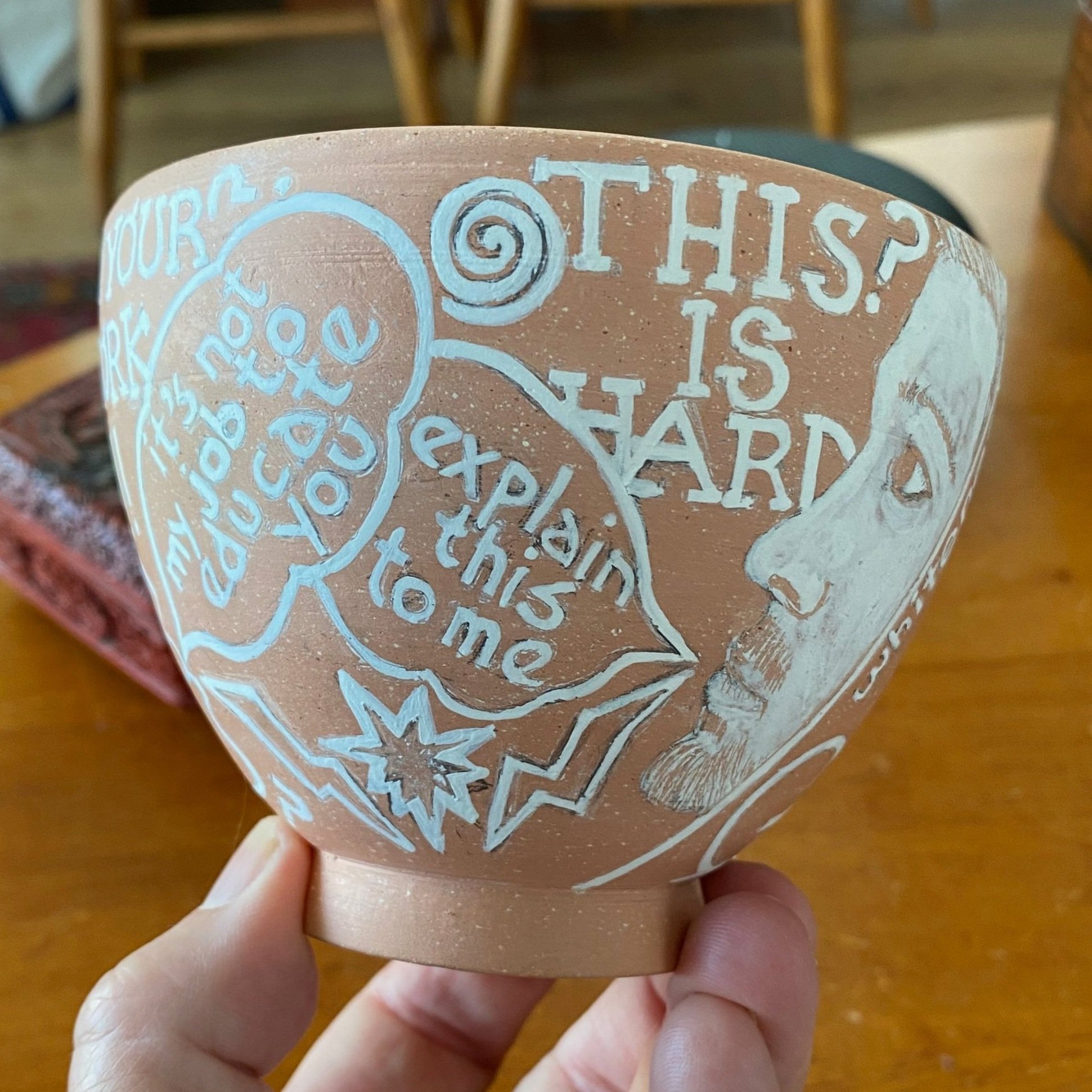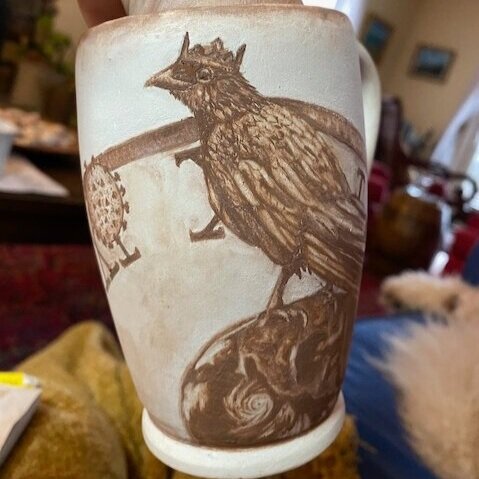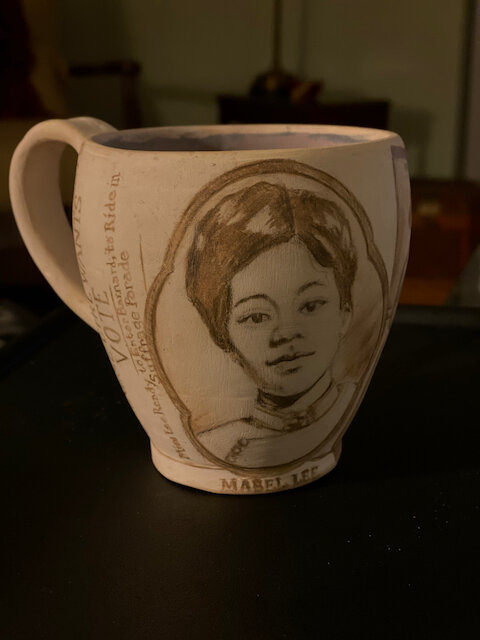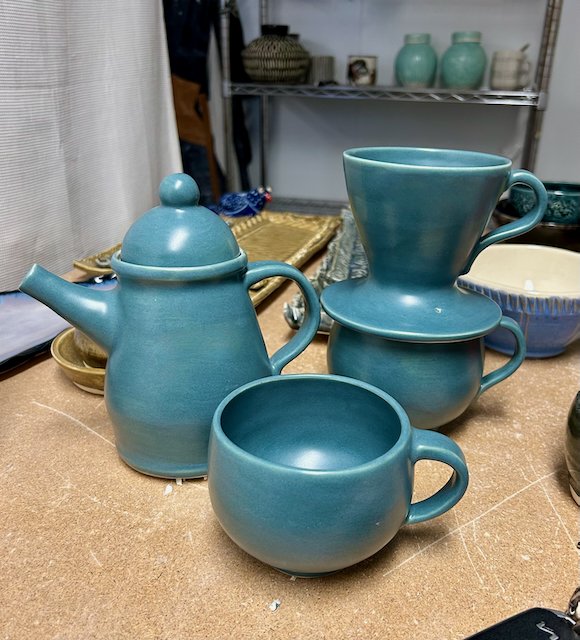Narrative Pottery & Inkware
Narrative pottery is an art almost as old as pottery itself, and simply refers to the art of illustrating pottery for the purposes of storytelling. A narrative potter tells stories using ceramic forms as their canvas.
“Inkware” is a term coined by my teacher, Seth Rainville, for the narrative pottery he creates by painting bisque porcelain with a tinted “slip,” (liquid clay) made with cobalt carbonate, chrome oxide, red iron oxide and ball clay. There are many different ways of tinting slip, but Seth’s formulation is — oddly enough — known as “Seth’s Black Ink” (SBI). SBI can be applied to bisque work almost like India ink, allowing for an unusual amount of depth and shading. It goes on looking sepia-toned, but in the final firing it turns shades of black.
When Seth introduced me to narrative pottery as a form of creative expression, and to SBI as a means with which to create it, I felt a whole new world open before me. One day in class, he was going to demonstrate using SBI and asked if anyone had a bisque piece he could use for the demonstration. I’d always loved drawing with pencil and painting with ink, so I quickly offered up a vase I’d made, on which he proceeded to ink a birch tree. “Now you do the rest,” he said handing it back. The mass shooting at Tree of Life Synagogue in Pittsburgh had happened not long before, so I knew right away what story I wanted to tell. The final piece, my first piece of narrative pottery, is included below.
Finally, because I love being able to see other artists’ work in process, I’m showing some of my own pieces here “in process,” both before and after their final firing. Most of these are inkware, though the more colorful pieces are decorated with underglazes, applied either before or after the bisque firing.

#MeToo: Fear

#MeToo: Shame

#MeToo: Rage




#MeToo: Fear, Shame, Rage (angle 1)

#MeToo: Fear, Shame, Rage (angle 2)

#MeToo: Fear, Shame Rage (angle 3)

Where the Light Gets In (before firing)

Where the Light Gets In (before firing)

Where the Light Gets In (before firing)

Where the Light Gets In (angle 1)

Where the Light Gets In (angle 2)

Where the Light Gets In (angle 3)

Eighteen Years (angle 1)

Eighteen Years (angle 2)

Eighteen Years (angle 3)

Eighteen Years (angle 4)

Eighteen Years (angle 5)

Eighteen Years (angle 6)

Google It, Brad (before firing)

Google It, Brad (before firing)

Google It, Brad (before firing)

Google It, Brad (angle 1)

Google It, Brad (angle 2)

Google It, Brad (angle 3)

Alleluia, Anyway! (before firing)

Alleluia, Anyway! (before firing)

Alleluia, Anyway (Angle 1)

Alleluia, Anyway (Angle 2)

Alleluia, Anyway (Angle 3)

Alleluia, Anyway (Angle 4)

Made to Connect (before firing)

Made to Connect (before firing)

Made to Connect (before firing)

Made to Connect (angle 1)

Made to Connect (angle 2)

Made to Connect (angle 3)

Justice for Elijah (sketch)

Justice for Elijah (in process)
Justice for Elijah (in process)
Justice for Elijah (before firing)

Justice for Elijah

Justice for Elijah (final)

Emily Was Wrong (final)

Emily Was Wrong (in process)

Emily Was Wrong (in process)

Dr. Mabel Ping-Hua Lee (1896-1966) (before firing)

Dr. Mabel Ping-Hua Lee (1896-1966) (before firing)

Dr. Mabel Ping-Hua Lee (1896-1966) (before firing)

Dr. Mabel Ping-Hua Lee (1896-1966) (before firing)

Dr. Mabel Ping-Hua Lee (1896-1966) (angle 1)

Dr. Mabel Ping-Hua Lee (1896-1966) (angle 2)

Love Is Stronger Than Death (before firing)

Love Is Stronger Than Death (before firing)

Love Is Stronger Than Death (before firing)

Love Is Stronger Than Death (angle 1)

Love Is Stronger Than Death (angle 2)

Love Is Stronger Than Death (angle 3)

Grace's coffee set. Porcelain, brush on glaze.



Mourning Faith (before firing)

Mourning Faith (before firing)

Mourning Faith (before firing)

Mourning Faith (angle 1)

Mourning Faith (angle 3)

Mourning Faith (angle 2)

Kingfisher Haiku (angle 1)

Kingfisher Haiku (angle 2)

Kingfisher Haiku (angle 3)

Strength & Wisdom (amgle 3)

Strength & Wisdom (angle 1)

Strength & Wisdom (angle 2)




Communion Set (bisque-fired, decorated with underglazes)

Communion Set (after firing)

Communion Set

Sartre's Dilemma (angle 1)

Sartre's Dilemma (angle 2)

Sartre's Dilemma (angle 3)

Alice


Alice

Space Folly (angle 1)

Space Folly (angle 2)

Space Folly (angle 3)

